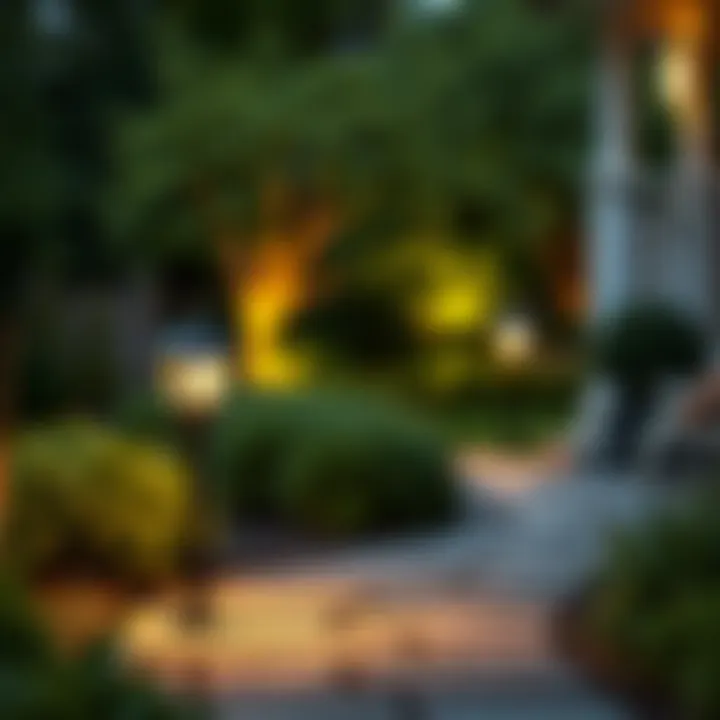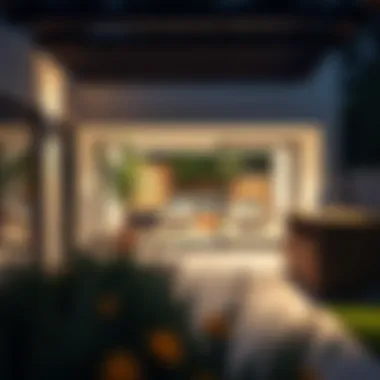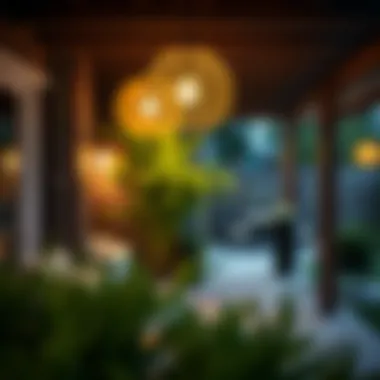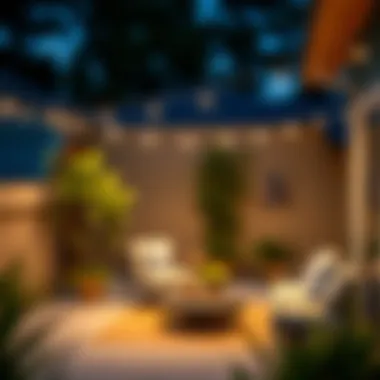Exploring Dimmable Exterior Lighting Options


Intro
Dimmable exterior lights are emerging as key players in the realm of outdoor illumination, shedding new light—literally—on what it means to create a captivating outdoor environment. As more homeowners, decorators, and realtors recognize the transformative power of lighting, the focus is shifting towards understanding how dimmable options can enhance both aesthetics and functionality in outdoor spaces.
The essence of dimmable lights lies not just in their ability to provide variable brightness, but also in how they can set the mood. Picture a summer evening where you can adjust the lighting from a bright, welcoming glow for guests to a softer, more intimate ambiance as the night wears on. This flexibility is what makes dimmable lights not just a trend, but a necessity for any outdoor setting.
Moreover, with the integration of smart technology, dimmable exterior lights offer homeowners unprecedented control over their lighting schemes. Whether it is through a smartphone app or voice activation, the ease of managing one's outdoor lighting enhances the overall experience significantly. In this article, we will closely examine the practical applications, advantages, and technical specifications of dimmable exterior lights, while also providing insight into design considerations and environmental impacts to support informed decision-making.
With a firm grasp on this topic, you will be well-equipped to illuminate your outdoor spaces in a manner that is not only visually striking but also energy-efficient and environmentally responsible. Let's dive deeper into what makes these lights a worthy addition to your property.
Understanding Dimmable Exterior Lights
Dimmable exterior lights are increasingly becoming a vital element in modern outdoor environments. As homeowners and designers strive to create spaces that are not just functional but also aesthetically pleasing, the role of lighting takes on added significance. Beyond mere brightness, dimmable lights offer nuanced control over ambiance, allowing one to tailor the illumination exactly to the mood and occasion. This adaptability makes them a popular choice, especially in settings such as gardens, patios, and entryways where the right lighting can significantly enhance the overall atmosphere.
Definition and Purpose
Dimmable exterior lights refer to lighting fixtures that allow users to adjust the brightness levels according to their preferences or needs. Unlike standard lighting options, which provide only an on-off function, these lights enable a spectrum of luminosity. The purpose is straightforward: to give individuals the power to create a desired environment, be it a cozy gathering under the stars or a brightly lit pathway for safety. In this way, the benefits extend beyond just aesthetics; they also include practical applications such as energy savings and enhanced security.
For instance, installing dimmable LED floodlights around a garden not only illuminates the space but can also highlight specific features like sculptures or landscaping, making the area visually captivating during twilight hours. This dual purpose underscores the significance of understanding how dimmable exterior lights function and their potential advantages.
Historical Context
The evolution of lighting has been a fascinating journey. Artificial lighting can be traced back to ancient civilizations, which used rudimentary means such as oil lamps. Fast forward to the advent of electric lights in the 19th century. These innovations dramatically changed how spaces were illuminated, but it remained a binary system—either on or off.
Dimming technology began to appear with the introduction of incandescent light bulbs. The first dimmers used in homes were essentially variable resistors, allowing users to dial back the brightness. However, it wasn’t until the late 20th century that dimmable lighting became more accessible, following the rise of LED technology. LEDs are not just energy-efficient; they inherently allow for precise control over brightness, paving the way for sophisticated dimming solutions available today. This historical progression highlights the importance of understanding dimmable exterior lights in the context of both practical use and the available technological advancements.
"Dimmable lighting transforms not just how we see, but how we feel in our spaces."
It’s essential for homeowners and designers alike to recognize that these lights are more than just fixtures; they are tools for crafting experiences. Whether one is hosting a gathering or simply seeking a serene sanctuary in their own backyard, the strategic use of dimmable lights can make a world of difference in defining the atmosphere.
Types of Dimmable Exterior Lights
When it comes to illuminating outdoor spaces, the types of dimmable exterior lights available play a crucial role in achieving desired ambiance and functionality. Not only do these lights enhance aesthetic appeal, they also allow for versatility in how spaces are used, allowing homeowners to create an environment that adapts to their needs at any given moment. Each type has unique characteristics that cater to different applications, making it vital to understand these distinctions.
LED Dimmable Lights
LED dimmable lights have gained popularity due to their energy efficiency and longevity. Unlike traditional bulbs, LEDs utilize considerably less power and provide a longer lifespan, making them an attractive option for both residential and commercial settings. Installation of LED lights can be seamless, as they can fit into standard fixtures without much hassle. Furthermore, with their ability to emit bright light while consuming less energy, they are a game-changer when it comes to reducing electricity bills.
"LED lights consume up to 75% less energy than incandescent bulbs and last up to 25 times longer."
When considering LED dimmable fixtures, it's crucial to ensure compatibility with dimmer switches. Not all dimmable LED bulbs work with every dimmer, which can cause flickering or unreliable dimming ranges. Homeowners should opt for LED lights specifically labeled as dimmable and check their compatibility with existing systems to avoid some costly mistakes in installation.
Halogen Dimmable Lights
Halogen dimmable lights are a better alternative compared to standard incandescent bulbs, as they provide brilliant, bright white light and can be easily dimmed to adjust brightness. They function by heating a tungsten filament enclosed in a small quartz envelope, allowing for a more focused and efficient light output. These fixtures can be particularly effective for highlighting landscapes or architectural details, creating striking contrasts in outdoor environments.
However, one must weigh the benefits against the drawbacks. Halogen lights are not as energy-efficient as LEDs and may drive up electricity costs over time. Usually, they emit more heat, which can be a concern in some contexts, particularly during warmer months. Moreover, their shorter lifespan compared to LEDs means more frequent replacements, thus requiring ongoing financial investment.
Smart Dimmable Lights
Smart dimmable lights represent the cutting edge of outdoor lighting technology. They allow users to control lighting through various devices, such as smartphones or voice-activated assistants. Smart lights can be programmed to adjust brightness based on the time of day or specific activities, lending unprecedented flexibility.
Homeowners interested in creating a seamless outdoor experience will find smart dimmable lights particularly appealing. Imagine being able to set the mood from the comfort of your couch or automatically dimming lights as the sun sets without lifting a finger. However, with great power comes certain responsibilities, as proper setup is essential for reliability and functionality.
Utilizing smart lights involves understanding wireless connectivity and ensuring robust Wi-Fi coverage throughout the outdoor areas mapped for illumination. With good prep work, the transformation of outdoor spaces can be made exhilarating.
In summary, each type of dimmable exterior light offers distinct advantages and potential downsides that cater to different needs. Understanding these options allows homeowners, interior designers, and decorators to choose the right fit for specific projects, ultimately enhancing the beauty and functionality of outdoor spaces.
Benefits of Dimming Capabilities
The advent of dimmable exterior lights has reshaped how we think about and utilize outdoor illumination. This innovation goes beyond just mere aesthetics; it holds significant practical advantages that can enhance both our daily lives and the environment. Let's break down the various perks of having dimmable capabilities in outdoor lighting.
Energy Efficiency and Cost Savings


Dimming functionality in exterior lighting is not just a fancy feature; it’s a strategic approach to energy consumption. By adjusting the brightness according to specific needs, homeowners can significantly cut down on their energy bills. When lights dim, they consume less power, which means less strain on your wallet as well as the grid. In fact, studies show that reducing light intensity by 50% can result in energy savings of up to 30% in certain contexts.
Additionally, dimmable lights can help mitigate the environmental footprint. Consider the cumulative impact of hundreds of households conserving energy during peak hours. It equates to less reliance on fossil fuels and a gradual shift towards greener energy solutions. Implementing these lights is akin to finding a gold mine in your electricity expenses, all while contributing positively to sustainability efforts.
Aesthetic Flexibility
One of the most compelling benefits of dimmable exterior lights is their aesthetic flexibility. They allow you to tweak your outdoor space's ambiance based on the occasion or time of day.
- During romantic dinners on the patio, lights can be dimmed for a soft glow, creating a cozy atmosphere.
- For outdoor gatherings, brighter settings might be more appropriate to facilitate conversations and activities.
Moreover, these lights can also interact with seasonal changes. In fall, for example, dimmable lighting can accentuate the warm hues of autumn foliage, while in summer, brighter settings might help counterbalance the long daylight hours. Homeowners and decorators alike can play with intensities like an artist with a palette, creating a custom outdoor aesthetic that mirrors their personal style.
Enhancing Safety and Security
The role of dimmable lights in terms of safety and security is an often-overlooked benefit. A well-lit exterior can deter potential intruders and accidents alike. Dimming features allow homeowners to customize lighting levels that increase safety without unnecessarily flooding the area with bright light.
- For instance, a dim setting might illuminate walkways and entry points subtly, providing guidance without creating glare. This makes it easier for residents and guests to navigate outdoor spaces safely at night.
- Moreover, using motion sensors in combination with dimmable lights can enhance security. Lights can brighten when motion is detected, creating an alert environment while conserving energy when no one is around.
In summary, the incorporation of dimmable exterior lights extends beyond decorative appeal. It fosters energy efficiency, encourages personalized aesthetics, and enhances safety measures — all elements that contribute to improved quality of life in residential settings. By weighing these benefits, it's clear that dimmable lights offer a blend of function and creativity that is hard to ignore.
"Integrating dimmable lights into your outdoor environment not only boosts visual appeal but also promotes sustainability and security. It’s a win-win for all!"
For further reading on the impact of lighting on home safety and energy efficiency, you can visit sources like Wikipedia or Britannica.
Thoughtful lighting is not just about illumination; it’s about creating spaces that feel secure, welcoming, and tailored to the household's lifestyle.
Key Considerations for Installation
When tackling the installation of dimmable exterior lights, there’s more to it than just picking a pretty fixture. The beauty of such lighting comes with a few critical considerations that ensure functionality, aesthetic appeal, and safety. Homeowners and designers alike need to think through various elements during the installation phase. This section guides you through crucial points, making sure your outdoor space shines just right.
Wiring and Electrical Requirements
First off, one mustn’t overlook the wiring and electrical requirements. It may seem tedious, but this groundwork is essential for a successful lighting setup. Generally, outdoor lighting requires weatherproof wiring and fixtures. Standard wire types suitable for outdoor use include UF (Underground Feeder) and NM (Non-Metallic) cables, especially if your lights are in moist areas.
The electricity supply should be compatible with the dimmer system being used. Many dimmers work well with either LED or incandescent lights, but it’s important to match the wattage to prevent failure or even worse, electrical hazards.
Consider hiring a qualified electrician to handle any complicated wiring tasks. Doing so not only ensures safety but also compliance with local building codes.
Placement and Spacing
Once the wiring is sorted, placement and spacing of the lights come next in line. Strategically placing lights can create layers of illumination that enhance safety and highlight architectural features. A general rule of thumb is to keep space between fixtures to about 6 to 10 feet, although this can depend on the brightness of the lights and the desired effect.
Areas that benefit from dimmable lighting include:
- Patios or decks
- Walkways and entry points
- Landscape features, such as trees or flower beds
A thoughtful arrangement of lights creates harmony, ensuring that your outdoor space feels welcoming and vibrant. Always take into account how the light will be perceived at different times and how it interacts with surrounding elements.
Compatibility with Existing Systems
Lastly, don't forget the compatibility with existing systems. If your outdoor setup includes a mix of different light types—say, a few older halogen fixtures or traditional lighting—engaging a dimmable system may need some adjustments. Not all dimmable lights are created equal, and plugging a dimmable LED into an older incandescent system can lead to flickering or degradation of performance.
To avoid this, consider the type of dimmer switches that may be necessary. Smart dimmers may offer the versatility of remote control but ensure that even traditional dimming options align with your existing lighting. Take a good look at any necessary adapters or transformers as well—these small components ensure that all parts work together in harmony.
In summary, preparation is half the battle when installing dimmable lights outdoors. By understanding wiring needs, strategic placement, and compatibility issues, you equip yourself with knowledge that can make your outdoor space glow just right.
Integration with Smart Home Systems
The advent of smart home technology has significantly transformed the way we interact with our living spaces, and dimmable exterior lights are no exception. Integrating these lighting fixtures with smart home systems not only enhances convenience but also opens doors to a world of possibilities in terms of energy efficiency, security, and ambiance control. As technology progresses, more homeowners are looking to connect their outdoor illumination with smart systems, allowing for seamless control and advanced features.
Overview of Smart Technology


Smart technology encompasses a variety of devices and systems that can be controlled remotely or programmed to operate automatically. This includes everything from smart bulbs to complete home automation systems like Google Home or Amazon Alexa. The ability to integrate dimmable exterior lights into these systems means you can customize your outdoor lighting down to the last detail.
A few key components often involved in this integration are:
- Smart Hubs: Centralized units that facilitate communication between devices.
- Wi-Fi or Bluetooth Modules: Allowing lights to connect to the internet or devices.
- Mobile Apps: Enabling control from smartphones, providing flexibility in managing light settings.
By pairing outdoor lights with smart technology, homeowners gain the agility to modify brightness levels, switch lights on and off, or even set schedules—all from a mobile device. This interconnectivity suits a variety of lifestyles and elevates outdoor living spaces to a new level, making evenings on the patio much more enjoyable.
Remote Control Options
The beauty of dimmable exterior lights paired with smart technology lies in their remote control capabilities. Homeowners can tune their outdoor lighting to perfection without stepping outside. The convenience of remote control offers benefits such as:
- Customization: Set the dimming levels according to mood or occasion, whether it’s a family gathering or quiet time.
- Energy Management: Monitor and manage energy usage from anywhere; if you're away for an extended time, you can turn off lights to save electricity.
- Security Features: Automatically light up pathways when someone approaches or program lights to mimic activity in the house while away, deterring potential intruders.
"Smart technology is not just about making our lives easier; it's about enhancing the very environment we live in."
Design Considerations for Dimmable Outdoor Lighting
When selecting dimmable exterior lights, it is crucial to consider various design elements that contribute to the overall functionality and appeal of your outdoor space. Lighting isn't just about visibility; it's about creating an experience. Different factors come into play to ensure that your choices not only complement your property but also meet practical needs. Doing so enhances your enjoyment of the space, while also fulfilling aesthetic and functional purposes.
Matching with Landscape Aesthetics
One of the key elements in designing outdoor lighting is ensuring that the fixtures complement the overall aesthetics of your landscape. The harmony between your lighting and the natural elements is essential. For instance, LED garden lights can be particularly well-suited for contemporary settings, featuring sleek lines and minimalist designs that resonate with modern architecture. Conversely, if your home exhibits a traditional style, opt for lanterns made of wrought iron or bronze, which instills a classic charm.
Do not overlook the power of color temperature, either. Warm white lights tend to be more inviting and tend to blend well with the natural beauty of gardens and lawns. To achieve this, consider options like soft white outdoor LEDs, which blend seamlessly with your landscape and create a welcoming environment as day turns to dusk.
Creating Ambiance and Mood
The ambiance created by your outdoor lighting can massively influence the mood of your gatherings. Whether hosting a summer barbecue or enjoying a quiet evening alone, properly dimmed lights can set just the right tone. Think about layering your light sources. Not all areas require the same intensity. Incorporating tasks lights, like those directed toward a seating area, with softer ambient lights scattered around ensures balance.
Light dimmers grant flexibility—allowing you to adjust brightness to fit the occasion. For example, softer lighting during a romantic dinner under the stars creates intimacy, whereas brighter lights might be necessary for family gatherings or social events. Investing in smart dimmable solutions can serve well here, with options to control levels from the palm of your hand.
Seasonal Adjustments and Design Adaptability
Outdoor lighting should not be static; the seasons dictate a shift in how you light your landscape. Dimmable lights offer versatility to adapt your lighting scheme according to seasonal changes. In fall, as darkness creeps in earlier, you might find that a little extra brightness can still allow for enjoyment of your yard while also highlighting autumn foliage.
As for winter, when days are the shortest, using dim lighting can accentuate holiday decorations without overpowering the surroundings. Consider utilizing fixtures that allow for height adjustments or portable lighting options, which can make it easy to refresh or modify your light design with the seasons.
The adaptability of your lighting scheme plays a vital role in maximizing the enjoyment of your outdoor spaces year-round.
In summary, when design considerations for dimmable outdoor lighting are made, it involves the melding of functionality and aesthetics, crafting an atmosphere that reflects personal style and enhances the beauty of the landscape. Making thoughtful decisions about the types of fixtures, their placement, and adaptability to various conditions ensures that your outdoor lighting remains as dynamic as your needs.
Comparative Analysis with Traditional Lights
Dimmable exterior lights, while becoming more popular, often invite comparisons with traditional lighting solutions like incandescent or fluorescent fixtures. This analysis highlights the significant differences, focusing on the benefits, performance, and practicality of each lighting option. This comparison not only informs consumers about what they are investing in but also equips the reader, be they an interior designer or a homeowner, with essential insights into making thoughtful lighting choices that improve functionality and ambiance.
Cost Efficiency
One of the most striking differences between dimmable exterior lights and traditional options lies in their cost efficiency. While purchasing dimmable lights might require a higher upfront investment, the long-term benefits often outweigh this initial expense. To break it down:
- Energy Consumption: Dimmable LEDs, for example, draw significantly less power than their incandescent counterparts. A typical dimmable LED can emit the same amount of light for a fraction of the energy cost. According to energy efficiency reports, LEDs can save up to 80% in electricity compared to older bulbs, which is great news for homeowners looking to cut down electricity bills.
- Longevity: The lifespan of dimmable lights is also worth considering. LEDs can last up to 25 times longer than incandescent bulbs. This means fewer replacements and a decrease in maintenance costs over time. For those living in areas with frequent bulb burnouts, opting for dimmable lights could save time, money, and hassle in the long run.
- Reduced Waste: When traditional lights burn out, they contribute to waste. Dimmable fixtures, particularly LED ones, operate longer, meaning fewer lights end up in landfills each year. Less waste is not only a cost-saving benefit but also an environmentally friendly practice.
In summary, when taking a close look at cost efficiency, dimmable exterior lights can yield substantial savings, making them a wise choice for the pragmatic buyer.
Longevity and Maintenance
Longevity and maintenance play crucial roles in a consumer's decision-making process. When dissecting how dimmable exterior lights stack up against traditional lighting, the long-term perspective offers compelling arguments for their adoption.
- Durability: Dimmable lights, especially high-quality LEDs, often feature sturdier designs that withstand outdoor conditions better than incandescent lights. With resistance to shocks, vibrations, and extreme temperatures, these lights prove to be a reliable investment.
- Less Frequent Replacement: Traditional fluorescent lights may need replacement more often, mostly due to flickering or total burnout. Dimmable lights generally remain functional for much longer, which means that homeowners can avoid the recurring chore of swapping burnt-out bulbs regularly.
- Simpler Upkeep: In general, dimmable lights come with fewer maintenance hassles. Most LED products don’t require special ballasts or starters, which simplifies installation and reduces problems over time. They also resist fading and discoloration, traits often found in traditional lights. A simple wipe down with a damp cloth keeps them looking great without need for special cleaning solutions.
"Investing in dimmable outdoor lighting is not just about illumination; it’s about creating a lasting environment that adapts to the homeowner's needs."


For further reading on sustainable lighting practices, visit U.S. Department of Energy.
For those exploring longevity statistics, Energy Star presents comprehensive reports on lighting efficiency.
Environmental Impact
The environmental impact of outdoor lighting, particularly dimmable exterior lights, deserves a thorough examination. As lighting technology advances, it becomes increasingly crucial to understand how these innovations affect our surroundings. Dimmable lights not only enhance the aesthetics of outdoor spaces but also bring forth significant benefits regarding sustainability and light pollution considerations.
Sustainability of Light Sources
When discussing sustainability, one must consider the materials and energy consumption associated with different lighting options. Dimmable LED lights stand out in this regard. LEDs utilize less energy compared to traditional incandescent or halogen bulbs, thereby decreasing the overall carbon footprint. This energy efficiency translates into lower greenhouse gas emissions, aligning with global efforts to combat climate change. Furthermore, many LEDs have longer life spans, which means less frequent replacements and reductions in waste. Opting for dimmable versions extends their service life even further, as using lower brightness settings can diminish wear and tear.
The shift towards sustainable light sources isn't just an aesthetic choice; it's a critical step for environmental preservation. By choosing dimmable LED lighting, homeowners, landscapers, and businesses can play a role in promoting a healthier planet.
Light Pollution Considerations
Light pollution is a growing concern in urban and suburban areas. Excessive and poorly directed lighting not only disrupts ecosystems but also negatively affects human health. Dimmable lights offer a solution by allowing users to control the intensity of light emitted. By adjusting brightness levels based on need and activity, one can minimize glare that affects both wildlife and nearby residents.
Moreover, dimmable lights can seamlessly blend into the surrounding environment. For instance, while illuminating a garden, dimming the lights at later hours not only preserves the nocturnal atmosphere but also reduces light spillage into the skies. This practice is vital for astronomers and those who cherish the natural night sky, allowing stars to shine brightly, free from urban glare.
"The effects of light pollution reach far beyond the aesthetic; they impact wildlife, human health, and climate stability."
Combatting light pollution is not merely a matter of engineering but comes down to conscious choices made by homeowners and designers alike. By incorporating dimmable exterior lights, they can significantly reduce their impact while creating beautiful, functional spaces. Understanding these considerations is essential for anyone involved in exterior design or home improvement.
In summary, addressing the sustainability of light sources and light pollution when discussing dimmable exterior lights not only captures the essence of responsible design but also shapes a better future for our environment.
Future Trends in Dimmable Lighting
As our lives become increasingly connected and our demand for customizable environments grows, the landscape of dimmable lighting is undergoing significant transformations. This section explores the trends emerging on the horizons of dimmable exterior lighting, spotlighting the technological advancements and design shifts that are molding the future. It's crucial for interior designers, homeowners, decorators, and realtors alike to grasp these developments, as they present not only aesthetic enhancements but also practical solutions to everyday lighting challenges.
Advancements in Technology
The strides being made in lighting technology are akin to watching a racecar zoom past ordinary vehicles. One of the striking innovations is the rise of adaptive lighting systems. These systems utilize sensors to adjust brightness based on natural light conditions and occupancy, optimizing energy usage without compromising on ambiance.
Moreover, smart lighting apps are becoming staples in modern homes. Users can now control dimmable lights with voice commands or through an intuitive app interface right from their smartphones. Technologies like Zigbee and Z-Wave are making DIY installations smoother than butter, allowing homeowners to create a smart exterior that is both functional and inviting.
The introduction of solar-powered dimmable lights is another leap towards sustainability. With solar panels absorbing sunlight during the day, they provide energy-efficient options for outdoor lighting after dusk. This not only saves on electricity costs but also reduces one’s carbon footprint—something that resonates deeply with environmentally-conscious consumers.
"The future of lighting isn't just about illumination; it's about creating spaces that adapt to our lifestyles, making us feel at home anywhere we go."
Emerging Design Trends
As dimmable lighting solutions evolve, so too do the designs that incorporate them. The trend of biophilic design emphasizes integrating plants and natural elements into the outdoor environment. Dimmable lights are now being strategically used to accentuate these natural features, creating a harmonious blend of light and greenery.
Additionally, minimalistic and geometric designs are gaining traction. Outdoor fixtures that boast sleek lines and subtle dimming capabilities allow homeowners to maintain an understated elegance while still offering flexibility in mood setting.
More than just functionality, the aesthetic appeal of these lights is becoming increasingly pivotal. Designers are now experimenting with color temperature adjustment in outdoor settings. Homeowners can customize not just the brightness but also the hue of their exterior lighting, allowing for a dynamic range that adapts to different moods and occasions.
As we gaze into the future, it's clear that dimmable lighting is not just a passing trend; it’s becoming a transformative tool for enhancing outdoor spaces and tailoring them to individual needs emmersed in a culture of adaptability and technology.
Culmination and Recommendations
The exploration of dimmable exterior lights culminates in a vital understanding of how their integration into both residential and commercial spaces can significantly enhance functionality, aesthetics, and energy efficiency. As outdoor lighting trends shift with evolving technology and design philosophies, recognizing the nuanced benefits offered by dimmable options becomes critical for homeowners and designers alike.
The highlighted points throughout the discussion underscore the emotional and practical impacts of well-designed lighting. Energy savings, ambiance creation, and safety enhancements are just a few employment facets. Dimmable lights not only elevate outdoor aesthetics but also adapt to varied activities, whether it be hosting vibrant gatherings or enjoying quiet evenings under the stars. Additionally, as environmental concerns grow, the ability to adjust brightness translates directly to lower energy consumption, making dimmable options an eco-friendlier alternative.
In this light, homeowners and designers should evaluate their outdoor lighting systems with the following considerations:
"Dimmable lighting can dramatically shift the character of a space, making it not only functional but also inviting and harmonious with nature."
Summary of Key Points
- Enhancement of Ambiance: Dimmable lights allow for customizable brightness, creating different moods depending on occasion.
- Energy Efficiency: By being able to lower light levels, energy consumption decreases, playing a role in cost savings and environmental responsibility.
- Flexibility in Usage: These lights can accommodate any outdoor activity, ranging from lively parties to quiet evenings.
- Compatibility with Technology: Many models integrate with smart home devices, allowing for high-tech, user-friendly operation.
Guidelines for Homeowners
- Assess Needs: Consider the specific activities that will take place in your outdoor space and choose dimmable lights that best fit those needs.
- Select the Right Type: Explore LED, halogen, and smart dimmable lights, weighing the pros and cons according to your preferences.
- Consult Professionals: Engage with lighting designers or electricians when planning installation, ensuring that electrical requirements and compatibility with existing systems are met.
- Experiment with Placement: Test various light placements before permanent installation to determine optimal light direction and shading.
- Stay Informed on Technology: Keep an eye on emerging trends in dimmable technology as continuous innovations can lead to better options.
These comprehensive insights ensure that readers, whether they are homeowners or design professionals, can embark on their journey with dimmable exterior lighting equipped with the right knowledge and foresight.



